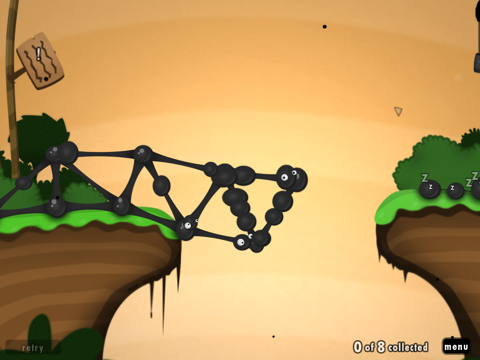Game developers, take note. 2D Boy has posted a detailed postmortem of its release of World of Goo on the iPad. The developers revealed some eye-opening information – the game has outsold any other platform release, including Steam and WiiWare, and in its first couple of months it’s already netted 125K sales – not bad for a port of a two-year-old game. The lengthy post gives some fascinating insight into what it takes to score a bona fide hit on the App Store, especially in the incredibly competitive games space.
[ad#Google Adsense 300×250 in story]World of Goo is a physics-based puzzle game (rated E for Everyone by the ESRB) first released for Windows and Mac in the fall of 2008. In World of Goo, you build structures using tar-like balls of goo, each with unique properties. The game has won a slew of awards and accolades since its release, including two awards from the Independent Games Festival.
After noting that console development is “where it’s at” for independent game developers, releasing World of Goo gave 2D Boy – an independent game development studio founded by two gaming industry veterans formerly employed by Electronic Arts – a completely different perspective:
“World of Goo’s launch on iPad gave us a new perspective on that discussion. In the first month of sales on the iPad App Store, World of Goo sold 125k copies (thanks to being prominently featured by Apple). In comparison, World of Goo’s best 31 day period on WiiWare was 68k copies (thanks to a mass mailing by Nintendo), and on Steam it was 97k copies (thanks to two promotions at discounted prices). So far, the iPad version is by far the fastest selling version of the game, both in terms of number of units sold and in revenue generated.”
2D Boy offered some interesting detail on how pricing affected sales performance. World of Goo was originally priced at $10, but later lowered to $5.
“It’s possible that $5 might have been a better price point to begin with,” the developers explained. “While $10 is less than most people pay for a movie ticket, or lunch, it’s still seen as a very high price for a game on the App Store and turns many people off.”
The price experimentation, paired with a careful study of App Store trends, compels the developers to think that if they ultimately do an iPhone game launch, they’re best off focusing on the dollar market. “At the time of writing, 18 out of the top 20 selling iPhone apps are priced at 99 cents. Of the top 20 grossing apps, 15 are either free or cost 99 cents.”
Other lessons learned included the importance of aiming to get the gam into top selling/top grossing charts on the App Store, the timing of the initial release (just before Apple staff went on Christmas break, helping to sustain visibility in the App Store), and the trials and tribulations of farming work out to other developers (four different contractors ultimately failed to bring World of Goo to iPhone initially).

